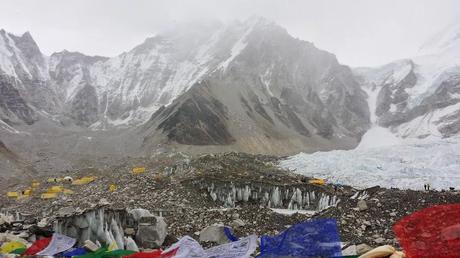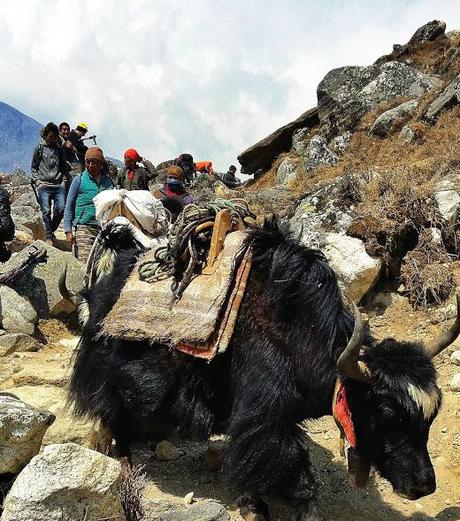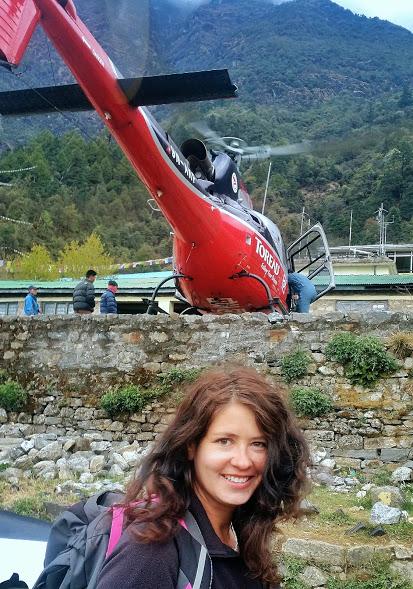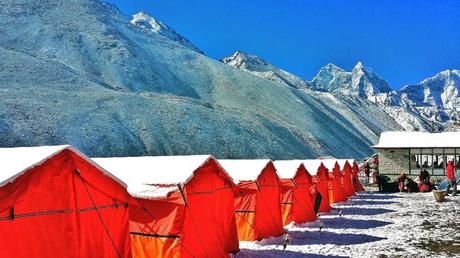I have just returned from hiking to Everest Base Camp with Yomads, which provides unique travel experiences for the 20s and 30s. It was a very strange time to start a trek – just days after the Everest tragedy, in which 16 sherpa guides were killed. I interviewed a couple of the climbers and will share my thoughts on that in an upcoming post.

Everest Base Camp (5360m)
It was with a mix of excitement and remorse, that I started my trek. Excited to trek to the highest altitude I would likely ever experience, but also guilt over the fact that I felt excited, when so much of the sherpa community was so devastated. I knew that I wouldn’t be in danger – Base Camp was my end point, not my starting point as it was for climbers attending Mount Everest, but still, it was an odd feeling.
I was also slightly anxious about traveling in a group. While I used to be an extrovert, after several years of working alone alongside my two cats at my kitchen table, I have gradually become more of an introvert. How would I handle 16 days of traveling with other hikers, plus guides? Fortunately, Yomads keeps the groups small, with a maximum of 16 participants – our group was 9 plus guides, porters and a chef.
My experience with Yomads was a positive one. My early days started with a cheerful, Good morning, tea? And as I crawled out of the warmth of my sleeping bag and zipped open my tent, our assistant guide Subash, would hand me a mug of steaming hot tea while inquiring how I had slept. A few hot sips of tea later, I braved the cold again, changing out of my thermals-which served as pajamas during my trip and into my cold hiking clothes, knowing that a hearty breakfast awaited me, prepared by our chef that accompanied us on our trek. Of special note is that I had informed Yomads of my gluten-allergy prior to the trip, and our guide Sujan carried buckwheat flour in his pack for me, for the entire 12 day trek. The chef used it to prepare the most delicious buckwheat pancakes I’ve ever tasted. That’s quite the treat – especially when you’re between 2800 – 5360m! Heck, I don’t usually get specially made pancakes even when I’m in a nice hotel – let alone while trekking, so for that I say a huge Thank you to Yomads. Travel tip: If you have a food or medical allergy, inform Yomads beforehand and they will do their best to accommodate it.

Porters and yak carrying goods to villages along the way to Base Camp.
Prior to heading to Nepal, I had heard stories of porters carrying huge loads wearing flimsy t-shirts and flip-flops and I saw quite a few porters that confirmed this. I was relieved when our guide Sujan confirmed that Yomads and World Expeditions (a travel company with a relationship to Yomads) informed us several times that porters were lined up to work for Yomads and World Expeditions since they were known to pay fairly, include meals throughout the trip and treat their staff well. That certainly seemed to be the case for our porters who were all very friendly. And all of them wore appropriate footwear for carrying 30 kg up a mountain for days on end. After carrying their heavy load for all of 5 steps, my respect and appreciation for them grew immensely and it was a relief to know they were being treated well.
Another factor that I hadn’t really considered before was the first aid training of our guide, but this is something every single member of our group came to appreciate at one time or another over the trip. Almost everyone experienced altitude sickness of some degree during our trek. It was a relief to discuss how to deal with it with Sujan, who really knew his stuff. I personally suffered from altitude sickness, a lung infection and bronchitis (as diagnosed by a pharmacist in our group).
But the most serious illness in our group occurred less than an hour of returning from Everest Base Camp to Gorak Shep, the highest eco-lodge we would stay at. A member in our group became very ill from altitude sickness compounded by other factors. She needed to be brought to a lower altitude but wasn’t able to walk. Sujan rounded up a few of our porters who piggy-backed her down the mountain for several hours so that she could recover at a lower altitude. A piggy back ride down a mountain, I’m not kidding!!!
Even more impressive, was that someone else not in our group, also needed to be brought down and it took over an hour for their guide to round-up porters to take her, while our porters volunteered in a matter of minutes. This is the type of service you hope you never need, and to a large degree altitude sickness can be prevented (hike slowly, stay hydrated, return to a lower elevation if you start to feel sick….) but if you do need to be brought down for whatever reason, you want a guide and porters that won’t hesitate to do it, as the ones from Yomads did! I think their willingness to do so is a testament to how well they’re treated.

Stranded in Lukla, waiting for a helicopter ride back to Kathmandu
I also hadn’t considered how important the connections of a company like Yomads or World Expeditions are….until we were stranded at Lukla, along with 1500 other hikers/climbers with all flights grounded due to poor weather. We met a couple of climbers and hikers who had been waiting for a helicopter for a couple of days. Due to the connections of Yomads, our entire group, minus one guide was able to fly out the same day! Travel tip: Many flights between Kathmandu and Lukla are cancelled due to bad weather. Either purchase travel insurance, or book your return flight home back several days after you are supposed to be back in Kathmandu, giving yourself a buffer in case of poor weather.
OK, I’ve talked about what I did like, so what were some of the negatives about our trek to Everest Base Camp?
Sujan and Subash tried to keep everyone together, but we soon realized as a group this wasn’t going to work. We had a couple of super fast hikers, some in the middle and some really slow ones. I for one, like to walk at my own pace and don’t want to feel like I have to keep up with someone, or stop every 10 minutes a wait. Once I get into a comfortable rhythm, I like to keep that pace. For the most part they would let us walk at our own pace, which I really appreciated, but on a couple of days, there were fairly long waits when we had to travel together as a group for park permits. It wasn’t the end of the world, but when traveling as a group, you have to accept that if you are a fast hiker, you will likely spend more time waiting for other hikers than you might like.
We were really fortunate to have a really nice group. Our group consisted of 3 ladies from Holland, 3 ladies from Australia, a Swiss mountain climber, an American rap videographer and myself. I enjoyed our group, but also made sure to get alone time everyday, usually by walking by myself for at least a couple of hours, and then back at camp or in the eco-lodge, I would curl up with a book and tune everyone else out. If I hadn’t taken the alone time, I would have struggled with the group dynamic – even though I liked everyone. But by spending part of my day alone, and taking time for myself, I enjoyed the time I did spend with the group.
I think that’s the key – recognize when you need time alone or away from the group and take it. Others in the group would slip on their headphones and listen to music. Do whatever you need to do, while still being respectful to the rest of the group. 16 days is a lot to spend with a group of strangers, even nice ones, so it’s important to make time for alone time when you need it.

One of Yomads permanent campsites en route to Everest Base Camp.
I’m admittedly not much of a camper and was worried about the camping nights, but these turned out to be preferable to the eco lodges, especially the higher up ones in which the cleanliness left something to be desired – especially the toilets. This is not a Yomads issue, but a trekking to Everest Base Camp issue. There is simply no such thing as a luxurious hotel the closer you get to Base Camp. The villages run off of solar power, and everything is brought in by porters or yaks. There are no roads – just a hiking trail. This is simply something you have to accept should you decide to hike to Everest Base Camp. Yomads permanent camps were a welcome change from the eco lodges and the tents were really clean.
In summary, I enjoyed my trek to Everest Base Camp with Yomads. I would recommend doing it with them if you are between the ages of 20 -30, like traveling with other people, and want a convenient way to reach base camp without worrying about arranging a guide and porters yourself. Their trips to Everest Base Camp run between October and April of each year.
I’ve got so much more to tell you about my trip to Everest Base Camp….stay tuned to find out what it’s really like, more photos, life on the trail, aka the Yak Highway and a couple of surprises!
&locale;&layout;&action;&width;&height;&colorscheme;
